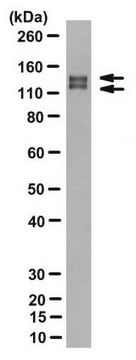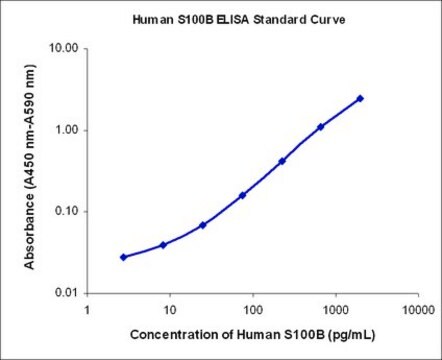MABC1126
Anti-EGFRvIII mutation Antibody, clone L8A4
clone L8A4, from mouse
Sinónimos:
Epidermal Growth Factor Receptor vIII
About This Item
Productos recomendados
biological source
mouse
antibody form
purified immunoglobulin
antibody product type
primary antibodies
clone
L8A4, monoclonal
species reactivity
human
packaging
antibody small pack of 25 μg
technique(s)
ELISA: suitable
flow cytometry: suitable
immunocytochemistry: suitable
immunohistochemistry (formalin-fixed, paraffin-embedded sections): suitable
western blot: suitable
isotype
IgG1κ
NCBI accession no.
UniProt accession no.
target post-translational modification
unmodified
General description
Specificity
Immunogen
Application
Apoptosis & Cancer
Immunohistochemistry (Paraffin) Analysis: A representative lot detected EGFRvIII mutation in Immunohistochemistry applications (Mellinghoff, I.K., et. al. (2005). N Engl J Med. 353(19):2012-24; Sok, J.C., et. al. (2006). Clin Cancer Res. 12(17):5064-73).
Immunohistochemistry Analysis: A representative lot detected EGFRvIII mutation in Immunohistochemistry applications (Wikstrand, C.J., et. al. (1998). J Neuroviral. 4(2):148-58; Wikstrand, C.J., et. al. (1995). Cancer Res. 55(14):3140-8).
ELISA Analysis: A representative lot detected EGFRvIII mutation in ELISA applications (Wikstrand, C.J., et. al. (1998). J Neuroviral. 4(2):148-58; Wikstrand, C.J., et. al. (1995). Cancer Res. 55(14):3140-8).
Flow Cytometry Analysis: A representative lot detected EGFRvIII mutation in Flow Cytometry applications (Wikstrand, C.J., et. al. (1998). J Neuroviral. 4(2):148-58; Wikstrand, C.J., et. al. (1995). Cancer Res. 55(14):3140-8).
Immunocytochemistry Analysis: A representative lot detected EGFRvIII mutation in Immunocytochemistry applications (Wikstrand, C.J., et. al. (1998). J Neuroviral. 4(2):148-58; Batra, S.K., et. al. (1995). Cell Growth Differ. 6(10):1251-9).
Quality
Western Blotting Analysis: 1 µg/mL of this antibody detected EGFRvIII mutation in NR6 cells expressing human EGFRvIII (NR6M).
Target description
Physical form
Storage and Stability
Handling Recommendations: Upon receipt and prior to removing the cap, centrifuge the vial and gently mix the solution. Aliquot into microcentrifuge tubes and store at -20°C. Avoid repeated freeze/thaw cycles, which may damage IgG and affect product performance.
Other Notes
Disclaimer
Not finding the right product?
Try our Herramienta de selección de productos.
Storage Class
12 - Non Combustible Liquids
wgk_germany
WGK 2
Certificados de análisis (COA)
Busque Certificados de análisis (COA) introduciendo el número de lote del producto. Los números de lote se encuentran en la etiqueta del producto después de las palabras «Lot» o «Batch»
¿Ya tiene este producto?
Encuentre la documentación para los productos que ha comprado recientemente en la Biblioteca de documentos.
Nuestro equipo de científicos tiene experiencia en todas las áreas de investigación: Ciencias de la vida, Ciencia de los materiales, Síntesis química, Cromatografía, Analítica y muchas otras.
Póngase en contacto con el Servicio técnico







